BRC环境监测风险评估英文版
全方位理解:环境监测制度英文版
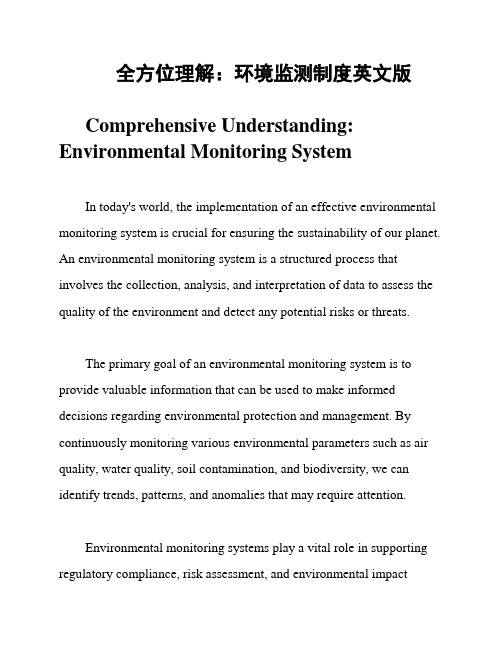
全方位理解:环境监测制度英文版Comprehensive Understanding: Environmental Monitoring SystemIn today's world, the implementation of an effective environmental monitoring system is crucial for ensuring the sustainability of our planet. An environmental monitoring system is a structured process that involves the collection, analysis, and interpretation of data to assess the quality of the environment and detect any potential risks or threats.The primary goal of an environmental monitoring system is to provide valuable information that can be used to make informed decisions regarding environmental protection and management. By continuously monitoring various environmental parameters such as air quality, water quality, soil contamination, and biodiversity, we can identify trends, patterns, and anomalies that may require attention.Environmental monitoring systems play a vital role in supporting regulatory compliance, risk assessment, and environmental impactassessments. They help organizations and governments track the effectiveness of environmental policies and regulations, as well as measure the success of environmental conservation efforts.In order to establish an effective environmental monitoring system, it is important to define clear objectives, select appropriate monitoring methods and technologies, establish monitoring stations at strategic locations, and ensure the accuracy and reliability of collected data. The data obtained from environmental monitoring activities can be used to develop action plans, set environmental targets, and evaluate the performance of environmental management programs.Overall, a well-designed environmental monitoring system is essential for promoting sustainable development, protecting natural resources, and preserving the quality of life for current and future generations. It is a powerful tool that enables us to better understand the complex interactions between human activities and the environment, and to take proactive measures to mitigate environmental risks and promote environmental stewardship.。
英语作文-环境风险评估与管控措施研究与案例分享
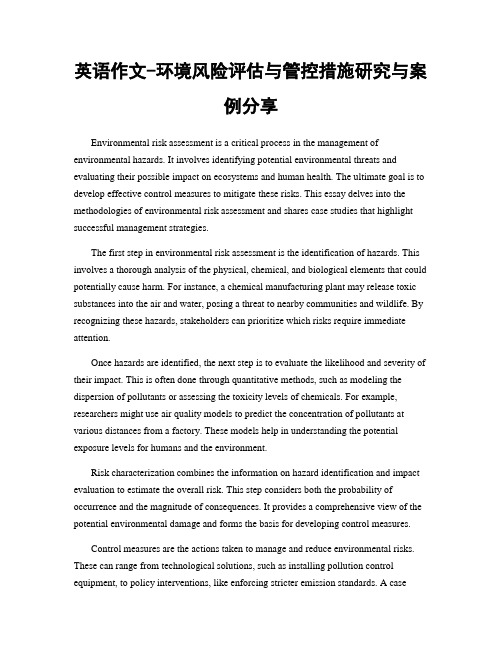
英语作文-环境风险评估与管控措施研究与案例分享Environmental risk assessment is a critical process in the management of environmental hazards. It involves identifying potential environmental threats and evaluating their possible impact on ecosystems and human health. The ultimate goal is to develop effective control measures to mitigate these risks. This essay delves into the methodologies of environmental risk assessment and shares case studies that highlight successful management strategies.The first step in environmental risk assessment is the identification of hazards. This involves a thorough analysis of the physical, chemical, and biological elements that could potentially cause harm. For instance, a chemical manufacturing plant may release toxic substances into the air and water, posing a threat to nearby communities and wildlife. By recognizing these hazards, stakeholders can prioritize which risks require immediate attention.Once hazards are identified, the next step is to evaluate the likelihood and severity of their impact. This is often done through quantitative methods, such as modeling the dispersion of pollutants or assessing the toxicity levels of chemicals. For example, researchers might use air quality models to predict the concentration of pollutants at various distances from a factory. These models help in understanding the potential exposure levels for humans and the environment.Risk characterization combines the information on hazard identification and impact evaluation to estimate the overall risk. This step considers both the probability of occurrence and the magnitude of consequences. It provides a comprehensive view of the potential environmental damage and forms the basis for developing control measures.Control measures are the actions taken to manage and reduce environmental risks. These can range from technological solutions, such as installing pollution control equipment, to policy interventions, like enforcing stricter emission standards. A casestudy that exemplifies effective control measures is the cleanup of the Hudson River in New York. After decades of pollution from PCBs, a combination of dredging and habitat restoration has significantly reduced the levels of contamination, leading to a healthier ecosystem.Monitoring and review are essential components of environmental risk management. They ensure that control measures are working as intended and allow for adjustments if necessary. Continuous monitoring of environmental indicators, such as water quality and biodiversity, provides data that can inform future decisions and policies.In conclusion, environmental risk assessment and control measures are indispensable tools in the pursuit of sustainable development. They enable us to understand and manage the complex interactions between human activities and the natural world. Through diligent application of these processes and learning from successful case studies, we can protect our environment and ensure a healthy planet for future generations.This essay has explored the intricate process of environmental risk assessment and the importance of implementing robust control measures. By examining real-world examples, it has demonstrated the positive outcomes that can be achieved when risks are managed effectively. The continuous evolution of assessment techniques and control strategies will play a pivotal role in safeguarding our environment against the myriad of risks it faces. 。
环保评价模板英语作文
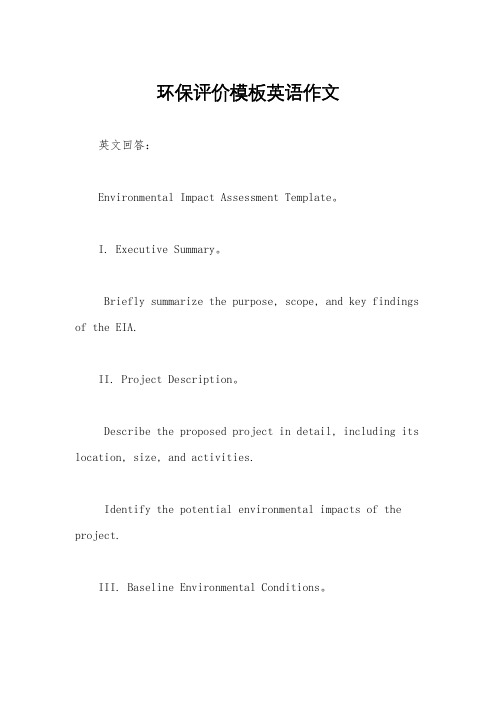
环保评价模板英语作文英文回答:Environmental Impact Assessment Template。
I. Executive Summary。
Briefly summarize the purpose, scope, and key findings of the EIA.II. Project Description。
Describe the proposed project in detail, including its location, size, and activities.Identify the potential environmental impacts of the project.III. Baseline Environmental Conditions。
Describe the existing environmental conditions at the project site and surrounding areas.This includes physical, biological, and socio-economic factors.IV. Impact Assessment。
Assess the potential impacts of the project on the environment.Use quantitative and qualitative methods to evaluate the magnitude, duration, and significance of the impacts.V. Mitigation Measures。
Identify and describe mitigation measures to reduce or eliminate potential impacts.These measures should be technically feasible, cost-effective, and environmentally sound.VI. Monitoring Plan。
BRC供应商风险评估、脆弱性评估(含附属excel全套资料)

Matrix Zonal Parameters矩阵带状参数
Likelihood of Occurrence
SSESSMENT, 5X5脆弱性评估,5X5
V.High:1 / High:2 / Medium:3 / Low:4 / V.Low:5
Matrix Zonal Parameters矩阵带 12.00 8.00 1.00
Overall Testing Overall Testing Likelihood of Method Likelihood of Occurrence Sophistication/ Method (=Average)发 Capability测试 Frequency测 Detection 生的总体可能 方法复杂化/ 试方法频率 (=Average) 性(=平均) 2.14 2.14 2.00 2.14 0.00 能力 5 3 3 3 3 3 3 3 4.00 3.00 3.00 3.00 0.00
V.HIGH (1) V.LOW (5) LOW (4) Low Low Low Low Low V.LOW (1) Medium Medium Low Low Low LOW (2) High High Medium Low Low MEDIUM (3) High High High Medium Low HIGH (4) High High High Medium Low V.HIGH (5)
VULNERABILITY ASSESSMENT, 5X5脆弱
V.High:5 / High:4 / Medium:3 / Low:2 / V.Low:1 高:5 /高:4 /中等:3 /低:2 / V:低:1
Nature Fraud Economic Ease of Supplier Raw history舞 factor经济 Access易 History供 Material天 Ingredient 弊史 因素 访问性 应商历史 然原料 成分
风险评估英文作文

风险评估英文作文1. Risk assessment is a crucial process in determining potential hazards and their likelihood of occurring. It involves analyzing various factors such as the nature of the activity, the environment, and the people involved. By identifying and evaluating risks, we can take appropriate measures to minimize or prevent them.2. When conducting a risk assessment, it is important to consider the potential consequences of each identified risk. This includes assessing the potential impact on people, property, and the environment. By understanding the potential consequences, we can prioritize our actions and allocate resources effectively.3. Another aspect of risk assessment is the evaluation of the likelihood of a risk occurring. This involves considering factors such as historical data, expert opinions, and current conditions. By assessing the likelihood, we can determine the level of urgency inaddressing the risk and implementing appropriate control measures.4. Risk assessment also involves considering the effectiveness of existing control measures. This includes evaluating whether the current measures are adequate in mitigating the identified risks. If necessary, additional control measures should be implemented to ensure the safety and well-being of individuals and the environment.5. Communication is an essential part of risk assessment. It is important to effectively communicate the identified risks and control measures to all relevant parties. This ensures that everyone is aware of the potential hazards and understands their responsibilities in managing and mitigating risks.6. Regular review and update of the risk assessment is necessary to adapt to changing circumstances and new information. Risks can evolve over time, and it is important to stay proactive in identifying and addressing potential hazards. By regularly reviewing the riskassessment, we can ensure its relevance and effectiveness.7. Risk assessment is not a one-time process, but rather an ongoing effort. It requires continuous monitoring and evaluation to identify any emerging risks or changes in existing risks. By staying vigilant and proactive, we can effectively manage and minimize potential hazards.8. Ultimately, risk assessment is about making informed decisions to ensure the safety and well-being ofindividuals and the environment. It is a dynamic process that requires careful consideration of various factors. By conducting thorough risk assessments, we can create a safer and more secure environment for everyone involved.。
最新BRC供应商原材料风险评估分析
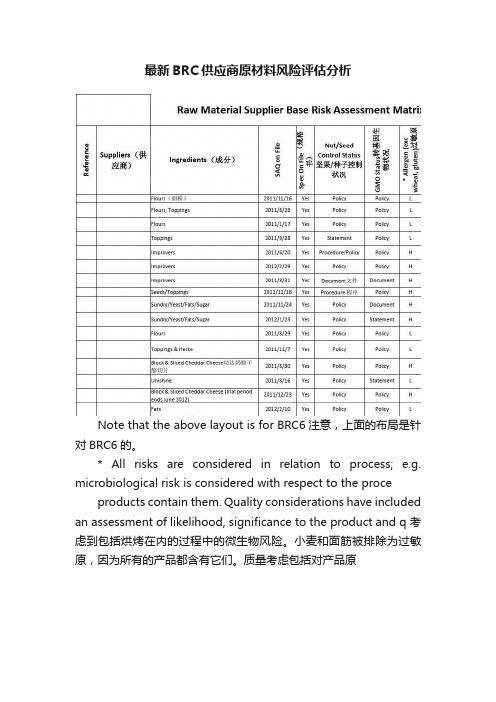
最新BRC供应商原材料风险评估分析
Note that the above layout is for BRC6注意,上面的布局是针对BRC6的。
* All risks are considered in relation to process; e.g. microbiological risk is considered with respect to the proce products contain them. Quality considerations have included an assessment of likelihood, significance to the product and q 考虑到包括烘烤在内的过程中的微生物风险。
小麦和面筋被排除为过敏原,因为所有的产品都含有它们。
质量考虑包括对产品原
process including baking. Wheat and gluten have been excluded as allergens as all ficance to the product and quantity affected if an issue were to arise.所有的风险都与过程有关;例如,有它们。
质量考虑包括对产品的可能性、重要性和数量的影响,如果出现问题的话。
全面版:环境监测规则英文版
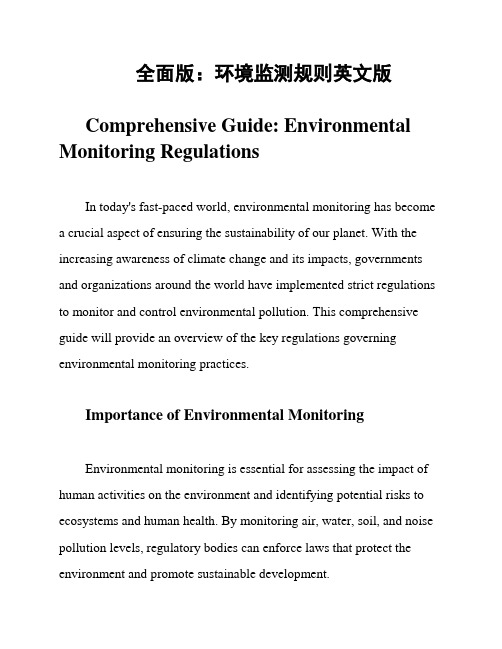
全面版:环境监测规则英文版Comprehensive Guide: Environmental Monitoring RegulationsIn today's fast-paced world, environmental monitoring has become a crucial aspect of ensuring the sustainability of our planet. With the increasing awareness of climate change and its impacts, governments and organizations around the world have implemented strict regulations to monitor and control environmental pollution. This comprehensive guide will provide an overview of the key regulations governing environmental monitoring practices.Importance of Environmental MonitoringEnvironmental monitoring is essential for assessing the impact of human activities on the environment and identifying potential risks to ecosystems and human health. By monitoring air, water, soil, and noise pollution levels, regulatory bodies can enforce laws that protect the environment and promote sustainable development.Key Components of Environmental Monitoring Regulations1. Air Quality Monitoring: Regulations require monitoring of air pollutants such as particulate matter, sulfur dioxide, nitrogen oxides, and volatile organic compounds. Monitoring stations are strategically placed in urban and industrial areas to assess compliance with air quality standards.2. Water Quality Monitoring: Regulations mandate monitoring of water bodies, including rivers, lakes, and oceans, to ensure compliance with water quality standards. Parameters such as pH, dissolved oxygen, turbidity, and heavy metal concentrations are monitored regularly.3. Soil Quality Monitoring: Soil quality monitoring is essential for assessing contamination levels and ensuring the health of agricultural lands. Regulations require testing for contaminants such as heavy metals, pesticides, and organic pollutants.4. Noise Monitoring: Regulations set limits on noise levels in residential, commercial, and industrial areas to protect human health and wellbeing. Noise monitoring stations are used to measure sound levels and identify sources of excessive noise.5. Waste Monitoring: Regulations govern the management and disposal of hazardous and non-hazardous waste materials. Monitoring waste generation, transportation, and treatment processes ensure compliance with waste management regulations.Compliance and EnforcementRegulatory bodies are responsible for enforcing environmental monitoring regulations and conducting inspections to ensure compliance. Non-compliance with regulations can result in fines, penalties, and legal action. Organizations are required to report monitoring data regularly and take corrective actions to address any violations.Future Trends in Environmental MonitoringAdvancements in technology, such as remote sensing, drones, and big data analytics, are transforming environmental monitoring practices. Real-time monitoring systems and predictive modeling tools are being developed to improve the efficiency and accuracy of environmental monitoring activities.In conclusion, environmental monitoring regulations play a crucial role in protecting the environment and public health. By following these regulations and adopting sustainable practices, we can create a cleaner and healthier planet for future generations.。
brc v9 食品安全全球标准 英文版

《brc v9 食品安全全球标准:从全面评估到深入理解》一、引言食品安全一直是全球关注的重要话题。
随着全球食品贸易的增加和消费者对食品质量和安全的重视,各国和企业也越来越重视食品安全标准的制定和执行。
在这样的背景下,BRC(British Retail Consortium)发布了第九版的食品安全全球标准(BRC v9),旨在为食品生产企业提供更严格、更全面的食品安全标准指导。
二、BRC v9 食品安全全球标准的深入评估1. 标准概述BRC v9 是一份涵盖食品安全管理系统的全面标准,重点关注食品生产企业的管理责任、风险评估和控制、生产环境、产品安全和质量控制等方面。
它的发布标志着食品安全管理的又一次升级,意味着食品生产企业需要更加严格地把控食品安全风险,确保生产的食品安全可靠。
2. 主要变化与更新在本版标准中,BRC v9 做出了一些重要的变化和更新,如对食品安全文化的要求更为强调,对供应链的管理更为注重,对风险评估和控制方面的要求更为细化。
这些变化和更新意味着食品生产企业需要更加注重整体的食品安全管理,而非仅仅满足一些简单的标准要求。
3. 深入理解通过对 BRC v9 的全面评估,我们可以深入理解其中所蕴含的食品安全管理理念和要求。
食品安全管理不仅仅是一份文件和制度,更是一种全员参与、持续改进的理念。
食品安全管理需要贯穿于生产的每一个环节,而非仅限于生产线上的操作。
食品安全管理需要企业追求卓越,不断超越标准的要求,以确保产品的安全和质量。
三、结语通过对 BRC v9 食品安全全球标准的深入评估,我们能更全面、深刻地理解食品安全管理的要求和意义。
在全球食品贸易日益频繁的今天,食品安全的重要性不言而喻。
我们期待更多食品生产企业能够遵循BRC v9 的要求,不断提升自身的食品安全管理水平,为全球食品安全贡献力量。
四、个人观点与理解作为一名食品安全管理者,我深知食品安全对于企业和消费者的重要性。
BRC v9 的发布与更新,让我更加清晰地认识到食品安全管理的要求和标准。
BRC供应商风险评估、脆弱性评估(含附属excel全套资料)

V.High:5 / High:4 / Medium:3 / Low:2 / V.Low:1 高:5 /高:4 /中等:3 /低:2 / V:低:1
Nature Fraud Economic Ease of Supplier Raw history舞 factor经济 Access易 History供 Material天 Ingredient 弊史 因素 访问性 应商历史 然原料 成分
Matrix Zonal Parameters矩阵带状参数
V.HIGH (1) V.LOW (5) LOW (4) Low Low Low Low Low V.LOW (1) Medium Medium Low Low Low LOW (2) High High Medium Low Low MEDIUM (3) High High High Medium Low HIGH (4) High High High Medium Low V.HIGH (5)
Overall Overall Vulnerability Vulnerability Category总 Rating总体脆 体脆弱性类 弱性等级 别
8.57 6.43 6.00 6.43 0.00
Medium Low Low Low 12 to 25
LOW MEDIUM HIGH
Supplier Relationship 供应商关系
Geographic Factors地理 因素
Ing1铟镓 Ing2 Flours Improvers
5 5 1 1
1 1 1 1
3 3 3 3
1 1 2 3
1 1 2 2
1 1 2 2
BRC-FOOD第八版食品安全全球标准风险评估表
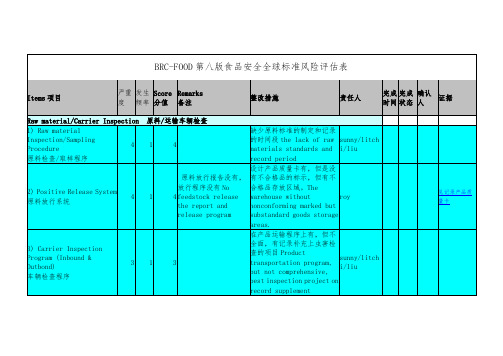
1
3
需要做标签贴到清洁工具里Label needs to be done to clean tools
peter/guo
15)Monitor the quality of water and steam used for food contact applications.有对食品接触的水和水蒸气的质量监控
4
1
4
包材供应商的资质证明,供应商审核清单,供应商评估记录?List of supplier audits, supplier assessment records
glen/guo/litchi
见程序供应商审核评估控制程序
8) Raw matertisl testing data review原料检测数据回顾
brcfood第八版食品安全全球标准风险评估表严重发生scoreremarks完成完成确认items项目整改措施责任人证据度频率分值备注时间状态人rawmaterialcarrierinspection原料运输车辆检查1rawmaterial缺少原料标准的制定和记录inspectionsampling的时间段thelackofrawsunnylitch414procedurematerialsstandardsandiliu原料检查取样程序recordperiod设计产品质量卡有但是没原料放行报告没有有不合格品的标示但有不放行程序没有no合格品存放区域
4
1
4
ok
peter
13) Control measure are in place reduce potential cross contamination生产过程中有措施预防潜在污染
4
1
4
无,次氯酸钠的标定记录和配置记录(生产期间的)No, sodium hypochlorite calibration records and configuration records (during production)
环境风险评估分析英语作文
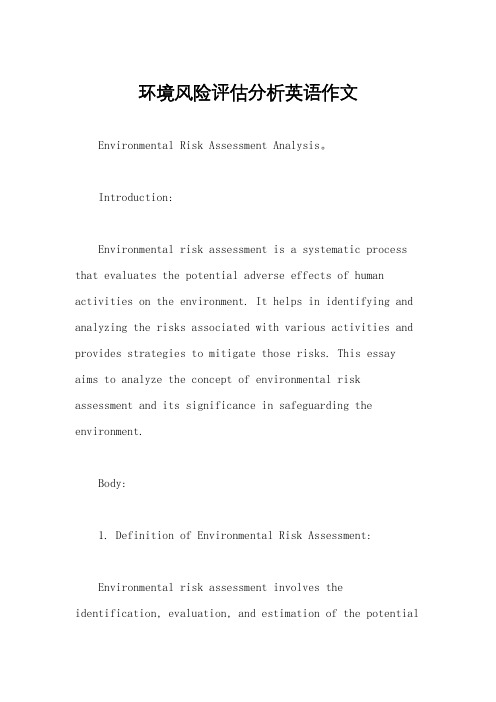
环境风险评估分析英语作文Environmental Risk Assessment Analysis。
Introduction:Environmental risk assessment is a systematic process that evaluates the potential adverse effects of human activities on the environment. It helps in identifying and analyzing the risks associated with various activities and provides strategies to mitigate those risks. This essay aims to analyze the concept of environmental risk assessment and its significance in safeguarding the environment.Body:1. Definition of Environmental Risk Assessment:Environmental risk assessment involves the identification, evaluation, and estimation of the potentialadverse effects of human activities on the environment. It considers various factors such as pollution, climate change, habitat destruction, and resource depletion.2. Importance of Environmental Risk Assessment:a) Protection of the environment: By identifying potential risks, environmental risk assessment helps in developing strategies to prevent or minimize adverseeffects on the environment.b) Sustainable development: It enables decision-makersto make informed choices by considering the environmental risks associated with different activities.c) Public health: Environmental risk assessment helpsin evaluating the impact of pollutants and contaminants on human health, leading to the development of measures to protect public health.3. Steps involved in Environmental Risk Assessment:a) Hazard identification: This step involvesidentifying potential hazards or risks to the environment. It includes analyzing the nature and characteristics of the activity and its potential impact.b) Risk assessment: In this step, the identified hazards are evaluated to determine the likelihood and severity of the adverse effects on the environment. It involves collecting and analyzing data to estimate the potential risks.c) Risk management: Once the risks are assessed, appropriate measures are developed to manage and mitigate these risks. This step includes the implementation of preventive measures and monitoring the effectiveness ofrisk management strategies.d) Communication and decision-making: The findings of the risk assessment are communicated to stakeholders and decision-makers to facilitate informed decision-making. This step ensures that the risks are understood and appropriate actions are taken.4. Examples of Environmental Risk Assessment:a) Industrial activities: Environmental risk assessment helps in evaluating the potential risks associated with industrial processes, such as chemical spills, air pollution, and waste disposal.b) Construction projects: It enables the assessment of risks related to habitat destruction, soil erosion, and pollution caused by construction activities.c) Energy production: Environmental risk assessment plays a crucial role in assessing the impact of energy production methods, such as fossil fuel combustion, nuclear power, and renewable energy sources.Conclusion:Environmental risk assessment is a vital tool in safeguarding the environment and promoting sustainable development. It helps in identifying potential risks,evaluating their impact, and developing strategies to mitigate these risks. By incorporating environmental risk assessment into decision-making processes, we can ensure the protection of the environment and the well-being of future generations.。
碳监测评估试点工作方案英文版

碳监测评估试点工作方案英文版The pilot project for carbon monitoring and assessment aims to establish a framework for evaluating and monitoring carbon emissions and sequestration in a specific area. The project will involve the development of a comprehensive plan to assess the carbon footprint of various activities and industries within the designated area. The plan will include the establishment of monitoring stations, data collection methods, and analysis techniques to accurately measure and evaluate carbon emissions.The project will also involve the implementation of innovative technologies and methodologies to assess the impact of human activities on carbon emissions and sequestration. This may include the use of remote sensing techniques, satellite imagery, and ground-based monitoring to track changes in land use, deforestation, and reforestation efforts. Additionally, the project will consider the impact of urbanization, industrialization, and agricultural practices on carbon emissions andsequestration.Furthermore, the pilot project will focus on engaging local stakeholders, including government agencies, businesses, and community organizations, to ensure their participation and support. Collaboration with relevant experts and researchers will also be essential to ensure the scientific rigor and accuracy of the assessment.In conclusion, the pilot project for carbon monitoring and assessment will involve the development of a comprehensive plan to evaluate and monitor carbon emissions and sequestration within a specific area. The project will utilize innovative technologies and methodologies, engage local stakeholders, and collaborate with experts to ensure the accuracy and effectiveness of the assessment.。
英语作文-环境风险评估与预警机制建设
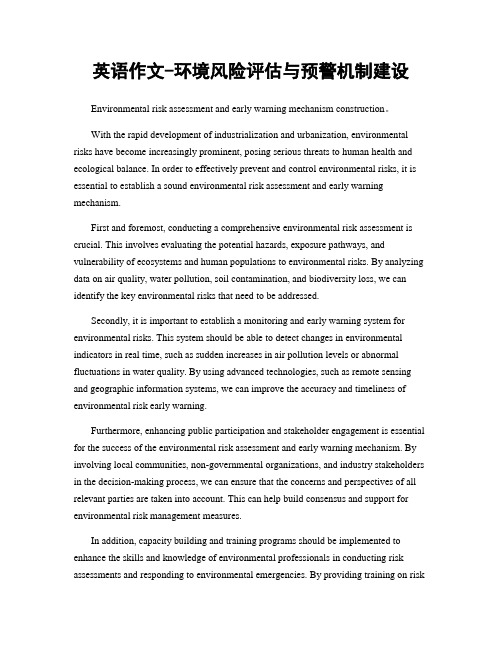
英语作文-环境风险评估与预警机制建设Environmental risk assessment and early warning mechanism construction。
With the rapid development of industrialization and urbanization, environmental risks have become increasingly prominent, posing serious threats to human health and ecological balance. In order to effectively prevent and control environmental risks, it is essential to establish a sound environmental risk assessment and early warning mechanism.First and foremost, conducting a comprehensive environmental risk assessment is crucial. This involves evaluating the potential hazards, exposure pathways, and vulnerability of ecosystems and human populations to environmental risks. By analyzing data on air quality, water pollution, soil contamination, and biodiversity loss, we can identify the key environmental risks that need to be addressed.Secondly, it is important to establish a monitoring and early warning system for environmental risks. This system should be able to detect changes in environmental indicators in real time, such as sudden increases in air pollution levels or abnormal fluctuations in water quality. By using advanced technologies, such as remote sensing and geographic information systems, we can improve the accuracy and timeliness of environmental risk early warning.Furthermore, enhancing public participation and stakeholder engagement is essential for the success of the environmental risk assessment and early warning mechanism. By involving local communities, non-governmental organizations, and industry stakeholders in the decision-making process, we can ensure that the concerns and perspectives of all relevant parties are taken into account. This can help build consensus and support for environmental risk management measures.In addition, capacity building and training programs should be implemented to enhance the skills and knowledge of environmental professionals in conducting risk assessments and responding to environmental emergencies. By providing training on riskassessment methodologies, data analysis techniques, and emergency response protocols, we can improve the effectiveness of environmental risk management efforts.Lastly, it is important to establish a coordination mechanism among government agencies, research institutions, and civil society organizations to promote information sharing and collaboration in environmental risk management. By working together and sharing resources, we can enhance the efficiency and effectiveness of environmental risk assessment and early warning activities.In conclusion, the establishment of a robust environmental risk assessment and early warning mechanism is essential for protecting human health and the environment from the threats of pollution and degradation. By conducting comprehensive risk assessments, establishing monitoring systems, enhancing public participation, providing training programs, and promoting collaboration, we can build a sustainable future for generations to come.。
环境风险评价
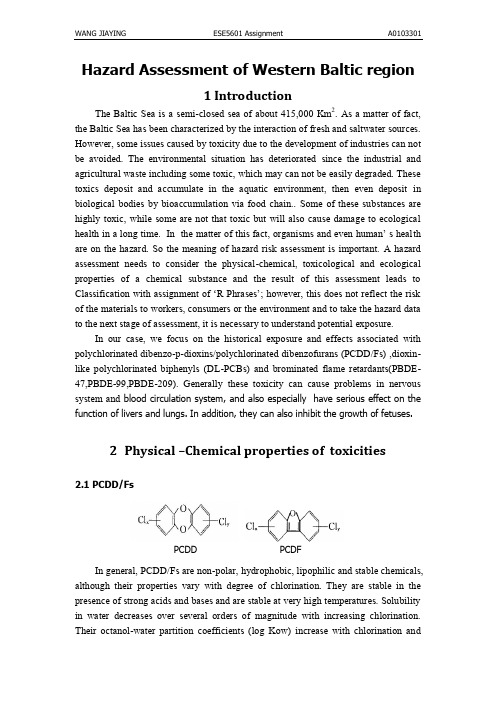
Hazard Assessment of Western Baltic region1 IntroductionThe Baltic Sea is a semi-closed sea of about 415,000 Km2. As a matter of fact, the Baltic Sea has been characterized by the interaction of fresh and saltwater sources. However, some issues caused by toxicity due to the development of industries can not be avoided. The environmental situation has deteriorated since the industrial and agricultural waste including some toxic, which may can not be easily degraded. These toxics deposit and accumulate in the aquatic environment, then even deposit in biological bodies by bioaccumulation via food chain.. Some of these substances are highly toxic, while some are not that toxic but will also cause damage to ecological health in a long time. In the matter of this fact, organisms and even human’ s heal th are on the hazard. So the meaning of hazard risk assessment is important. A hazard assessment needs to consider the physical-chemical, toxicological and ecological properties of a chemical substance and the result of this assessment leads to Classificat ion with assignment of ‘R Phrases’; however, this does not reflect the risk of the materials to workers, consumers or the environment and to take the hazard data to the next stage of assessment, it is necessary to understand potential exposure.In our case, we focus on the historical exposure and effects associated with polychlorinated dibenzo-p-dioxins/polychlorinated dibenzofurans (PCDD/Fs) ,dioxin-like polychlorinated biphenyls (DL-PCBs) and brominated flame retardants(PBDE-47,PBDE-99,PBDE-209). Generally these toxicity can cause problems in nervous system and blood circulation system, and also especially have serious effect on the function of livers and lungs. In addition, they can also inhibit the growth of fetuses.2Physical –Chemical properties of toxicities2.1 PCDD/FsPCDD PCDFIn general, PCDD/Fs are non-polar, hydrophobic, lipophilic and stable chemicals, although their properties vary with degree of chlorination. They are stable in the presence of strong acids and bases and are stable at very high temperatures. Solubility in water decreases over several orders of magnitude with increasing chlorination. Their octanol-water partition coefficients (log Kow) increase with chlorination andare among the highest measured for environmental organic contaminants. Changes in properties with chlorination/molecular mass, result in an increased tendency to partition into soils and sediments and to the particulate phase of air and water. Melting points and predicted boiling points of PCDD/Fs from B.Rordorf [1989] are given in Table 1.Estimated temperature dependencies are given in Table 2.Temperature dependencies of PCDD/Fs vapor pressure derived from these estimates are given in Table 3.Temperature dependencies of Henry law constant for PCDD/Fs are given in Table 4.2.2 DL-PCBsDL-PCBsPolychlorinated biphenyls or PCBs are a group of extremely stable aromatic chlorinated compounds which, like dioxins, are relatively resistant to biological degradation and hence persist and accumulate in the environment and in the food chain. There are 209 structurally possible PCB compounds (congeners), with one to ten chlorine atoms per molecule. They have excellent electrical and heat transfer properties, which led to their widespread use in a variety of industrial, commercial and domestic applications. Some poly-chlorinated biphenyls (PCBs) are called dioxin-like PCBs (DL-PCBs) because they have a structure very similar to that of dioxins and have dioxin-like effects.Some toxicologic parameters are in table 5.Basic chemical and physical data are in table 6.2.3 PBDEsPBDEsPBDEs are highly water insoluble, hydrophobic substances. Commercial penta BDE is a viscous liquid, but pure congeners and the other commercial products are solids at room temperature. PBDEs are semivolatile compounds with low vapour pressure and low water solubility. In the air, they exist in the gaseous phase and in the particulate phase. Due to the low vapour pressure they tend to be strongly attracted to air particles, but the amount actually associated with particles is dependent on temperature, particle size and of course, particle concentration. Generally, a greater amount exist in the gaseous phase during warm periods than during cold periods,because of the temperature dependence of the physical-chemical properties. In aquatic environments, PBDEs mainly become attracted by particles, because of the low water solubility.Physical-chemical properties of PBDE-47, PBDE-99, PBDE-209 are in table 7.3.Toxicity bioaccumulation and hazard risk assessment3.1 Toxicity bioaccumulation3.1.1Mobility, fate and transport of PCDD/Fs in the environmentMobility of PCDD/Fs is extremely low since it has a very low solubility in water and high adsorption capability. Therefore PCDD/Fs always accumulate in fatty tissue in biological body. The air-vegetation-livestock-human pathway is probably the most important route of human exposure.Accumulation of PCDD/Fs in the food chain is a consequence of their solubility in fats. Bioaccumulation is high in fish as well as in fat and in the liver of terrestrial organisms. However, accumulation in plants is moderate. The main route of PCDD/Fs to vegetation is via direct deposition from the atmosphere. PCDD/Fs is mainly the by-product of the industrial process, but it also widely exists in the nature in a normal low concentration because of some natural processes, such as volcanic eruptions and forest fires. PCDD/Fs are harmful by-productions from metallurgy, chlorine bleaching and pesticide manufacture industries. The most reprehensible problem harming environment is from waste incinerations, such as solid waste and medical waste incineration. The problem is mainly caused by insufficient combustion.Although the mobility of PCDD/Fs incorporated into sediment is thought to be minimal, there is evidence from laboratory studies that transformation of PCDD/Fs via reductive dechlorination can occur. The dechlorination process is expected to be much slower in the environment however. Soil, along with sediment, is the ultimate destination for PCDD/Fs. Once PCDD/Fs have been deposited to soil there is very little transformation or movement and estimated half-lives for PCDD/Fs in soil are decades. After PCDD/Fs entre the atmosphere, they will be transported by advective process. Most of PCDD/Fs may be deposited from the atmosphere to the ground, vegetated and water surfaces by three processes:1)Dry deposition of gases and particles, which means it directly interact between the atmosphere and the ground.2)Wet deposition. It comes down companying with falling hydrometeors.3)Occult deposition. It exists in fog droplets which do not fall under gravity because of their small size)3.1.2 Mobility, fate and transport of DL-PCBs in the environmentAccumulation in humus layer with little mobility; following sorption, mobility by way of vapor phase. There is very little degradation; the persistence increases with the degree of chlorination.Moreover, due to their chemical stability and persistence, PCBs could be globally distributed by the movement of water, atmosphere, and food cycle. Once in the environment, PCBs are highly resistant to chemical and biological degradation. PCBs, particularly the highly chlorinated ones, have been known to persist in water soils, sediment and biota for long periods of time.Although PCBs have low solubility in water, the immense amount of water in the oceans is still capable of holding a significant quantity of PCBs. In water, PCBs can be existed in the form of either truly dissolved or adsorbed suspended particles. Due to the presence of suspended particles with adsorbed PCBs, the amount of PCBs in water can sometimes exceed than what theoretically expected from the PCB's water solubility. Furthermore, the presence of human waste and dissolved organic carbon in water could also enhance the solubility of PCBs. The transport of PCBs in oceans is mainly due to the ocean current, and the ocean current between continents could easily transport PCBs from one country to another country.3.1.3 Mobility, fate and transport of PBDEs in the environmentThe environmental patterns of PBDEs in the air vary from the patterns in soil, sediment, and sludge. PBDEs strongly adsorb to these matrixes, and the congener patterns tend to reflect those in the commercial mixtures, except in sludge.Biodegradation is not an important pathway for the PBDEs, but photolysis possibly plays an important role in their transformation. When PBDEs existing in biological fat exposure in sunlight, more potentially toxic and more bioavailable with lower brominated will form. Due to the uncertainty in vapour pressure, the results obtained for BDE 209 possibly differ from the actual truth. Adopting a lower vapour pressure yields a higher amount partitioning to aerosols, which also increases the deposition of this chemical and thus the concentration in soil, urban film and sediment. Due to the large surface area of water, increased deposition also shifts the relativedistribution from soil to sediment, resulting in a higher percentage residing in sediment and a lower in soil.3.2 Toxicological hazard to organisms in the aquatic environment (ecological health)3.2.1 PCDD/FsAquatic environment, as the most important ecology environment, plays the key role in accumulation of PCDD/Fs. As presented in the fig.1, PCDD/Fs in the fresh water has a growing accumulated concentration before 1980 and then decreases. This situation may caused by the fact that the organisms such like zooplankton and fish in the water exposes in such aquatic environment and then deposit toxicities by eating. But fortunately, from the data we got from CoZMoMAN, we can figure that the highest concentration is only 1.99E-17 g/m3, which will only cause slight even no damage to organisms in the water. But the concentration in fish and zooplankton is much higher. From the figure4.1, we can know that the concentrations in organisms changes widely from 0 to 0.015 as different ages. The more mature organism accumulate more toxicity, absolutely supper more from the damage.3.2.2 DL-PCBsFish and other seafood are the main contributors to total TEQ intake from DL-PCBs. However, those individuals in some groups of organisms, which frequently consume high quantities of certain species , could significantly increase their DL-PCB intakes. Their environmental persistency, bioaccumulation and toxicological effects could be potentially similar to those of PCDD/Fs. We can know from fig.2, the concentration in fresh water and sediment both increase to the peak when 1975 and goes down afterwards. The sediment concentration increase as a result of the sedimentation of the toxicity.And the reduction may be contributed to ingestion and adsorption by organisms in the water. Although the peak number 2.66E-13 ng/g and 9.32E-13 ng/g are ignorable, we can also know from the data(fig4.2) that the peak of concentration in organisms in the water is relatively high, especially in 9-10 years herrings fat of 0.015ng/g. In this fact, fish and zooplankton are on hazard of PCBs, getting worse as the exposure time extents.3.2.3 PBDEsFrom the figure3, it can be obvious that the trend of concentrations on fresh water and sediment are mostly same. This phenomenon can due to the sedimentation and ingestion. Toxicities continuously settle into the bottom as small particle and those in the seawater are intaken by fish and zooplankton. Then toxicities concentrate and accumulate in fat in a much higher concentration.At the same time, by comparing with the data from CoZMoMAN, as figure(4.3-4.5), the accumulation in fish and zooplankton obviously concentrated and may cause significant effect on to different ages of organisms’ health . Effects of PBDEs have been reported in algae, invertebrates and in fish. In fish, fatty liver and reduced spawning are the main consequence.3.3 toxicological hazard to humans (human health)Comparing toxic accumulation concentration with LD50 of mouse. As the safety factor of human is 1000, LD50 (human)=LD50(mouse)/1000.3.3.1 PCDD/FsIn this case, TDLo of PCDD/Fs is 0.1 mg/kg. In the figure5.1, we can find that the concentration in humans is at most 0.035ng/g , which means that accumulation in human body is far below the damaging concentration. However, the effect of PCDD/Fs should not be ignore if humans are exposed in PCDD/Fs for a very longtime. Long time exposure may cause damage of the immune system, development of the nervous system, endocrine system and reproductive function. Chronic exposure to dioxins has lead to several types of cancer in animals. The growing fetus are the most sensitive group with PCDD/Fs. The growth of organ system can be effected, too. If humans shortly exposure to high levels of dioxins, they may have skin lesions, such as acne and skin discoloration. PCBB/Fs can also cause alteration of liver functions.3.3.2 DL-PCBsThe less serious concentration of long-evans rat is 1mg/kg, so the value for human is nearly 1ng/g . This value is also much higher than the peaks of graphs(fig 5.2) which presents DL- PCBs concentration in man and female human bodies. This fact may caused by their extremely stable chemical property and high sedimentation rate in the sea. Thus this kind of toxicity can be mostly tested in aquatic environment and fish fat. However, PCBs are generally regarded as having potential to cause adverse effects on health, with particular concern being expressed about the 12 so-calleddioxin-like PCBs. This group of non-ortho (PCB 77, 81, 126, 169) and mono-ortho (PCBs 105, 114, 118, 123, 156, 157, 167, 189) PCBs are assumed to have essentially the same toxicity potential as the dioxins and furans. It can be observed that human from 40-50 ages have much more concentrations than other age groups. People intake even low concentrations of DL-PCBs, also can be damaged because of its long life-time and low metabolism rate. Serious poisoning caused by PCB can bring out diarrhea, ataxia, inhibition of central nerves, etc, and even death. Toxic of PCB depends on animal species, sex, spread path, chemical structure of the PCB itself, and the different impurities. Human is probably one of the most sensitive species. PCBs can be easily intaken by humans via gastrointestinal tract, lungs, and skin. After entre human body, PCBs widely spread to the hole body, and mostly deposit in liver and fat. PCB in the matrix can transfer to the fetus via the placenta, and PCB in the fetal liver tend to be higher than the tissue of mothers. So damage to fetus are even more serious than adults. The contribution from dietary changes of young women, which may partly explain the more rapidly decreasing trend of DL-PCB concentrations in humans.3.3.3 PBDEsAccording to the data and figures(fig5.3-5.5) about the concentrations in human body, we can know that the concentration of PBDE-209 kept increasing by now, and there is no decreasing trend. Thus, we can infer that the PBDEs concentration can continue to increase and there is a possibility that it can exceed the less serious damaging concentration and cause damage to human health. Whereas, the concentration of PBDE-47 and PBDE-209 reach the peak in 2005 and then tend to decrease due to the high metabolism rate. Young people are under more risk of being damaged by toxicities. Very serious health effects are associated with exposure to PBDEs, but toxicity depends on the compound and the amount that one is exposed to. PBDEs are chemically similar to PCBs and, not surprisingly, they show similar health effects as well. They are biomagnified toxic compounds, meaning they accumulate within food chains. In contrast to penta-BDE, deca-BDE is poorly absorbed which may limit its potential toxicity. Toxicity testing indicates that PBDEs may cause liver, thyroid, and neuro developmental toxicity .There is also a study showing that exposure to very high doses of deca-BDE can cause tumors.4 ConclusionAccording to the risk assessment results, we can get conclusions blow:●In the bioaccumulation system, toxicity concentration in aquatic organisms are much higher than those in human bodies. Therefore hazard risk in aquatic environment is regarded under more risk.●Although most of the accumulation concentrations haven’t exceeded the damaging concentration, long time exposure will also have toxicological hazard to organisms in The aquatic environment and humans.●Damages caused by these organic toxicity mainly effect on nervous system, blood circulation system,development of organisms and functions of visceral organ.Table1. Melting and boiling points of PCDD/FsTable 2. Solubility of PCCD/Fs in water as a function of temperatureTable 3.Temperature dependence of vapor pressure of PCCD/FsTable 4.Temperature dependencies of Henry law constant for PCDD/FsTable 5. Parameters of PCBsTable 6. Basic chemical and physical dataTable 7.Physical-chemical properties of PBDE-47, PBDE-99, PBDE-209Figure 1. concentration of PCDD/Fs in ng/gPOCfresh water concentration of PCDD/Fs in ng/gPOC sediment concentration in PCDD/Fs ng/gPOCFigure 2 concentrations of DL-PCBsFreshwater con of DL-PCBs Sediment con of DL-PCBsFig 3. Concentration of PBDEsFresh water con of PBDE-47 Sediment con of PBDE-47Fresh water con of PBDE-99 Sediment con of PBDE-99Fresh water con of PBDE-209 Sediment con of PBDE-209Figure 4. 1PCDD/Fs of aquatic organisms (ng/g)Figure 4. 2 DL-PCBs of aquatic organisms (ng/g)Figure 4.3 PBDE-47 of aquatic organisms (ng/g)Figure 4.4 PBDE-99 of aquatic organisms (ng/g)Figure 4.5 PBDE-209 of aquatic organisms(ng/g)、Figure 5. 1 PCDD/Fs of humans (ng/g)Figure 5. 2 DL-PCBs of hunmans (ng/g)Figure 5.3 PBDE-47 of humans(ng/g)Figure 5.4 PBDE-99 of humans (ng/g)Figure 5.5 PBDE-209 of humans (ng/g)。
BRC环境监控计划风险评估报告
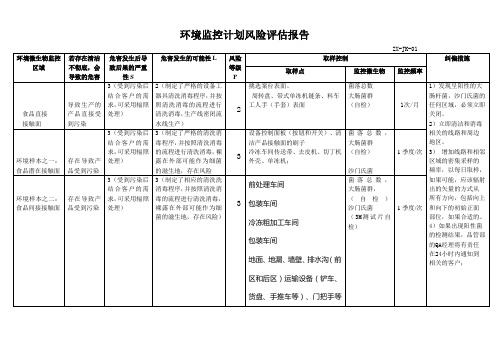
环境样本之一:食品潜在接触面
存在导致产品受到污染
3(受到污染后结合客户的需求,可采用辐照处理)
3(制定了严格的清洗消毒程序,并按照清洗消毒的流程进行清洗消毒,裸露在外部可能作为细菌的滋生地,存在风险
3
设备控制面板(按钮和开关)、清洁产品接触面的刷子
包装车间
冷冻粗加工车间
包装车间
地面、地漏、墙壁、排水沟(前区和后区)运输设备(铲车、货盘、手推车等)、门把手等
菌落总数, 大肠菌群,
(自检) 沙门氏菌
(3M测试片自检)
1季度/次
环境样本之三:过渡区
存在导致产品受到污染
3(受到污染后结合客户的需求,可采用辐照处理)
2(远离产品生产线,若存在致病菌如沙门氏菌的问题可导致厂区及生产线交叉污染)
2
挑选案台表面、
周转盘、带式单冻机链条、料车
工人手(手套)表面
菌落总数
大肠菌群
(自检)
1次/月
1)发现呈阳性的大肠杆菌,沙门氏菌的任何区域,必须立即关闭。
2)立即清洁和消毒相关的线路和周边地区。
3) 增加线路和相邻区域的密集采样的频率,以每日取样,如果可能,应该辐射出的矢量的方式从所有方向,包括向上和向下的初始正面部位,如果合适的。
2
维修室、包装存放间、清洗间、卫生间、过渡区
(货物缓冲区等)
菌落总数, 大肠菌群,(自检) 沙门氏菌(3M测试片自检)
1季度/次
附件:危害风险分级表:
严重性 可能性
可能性L
L5频繁
L4经常
L3偶尔
L2很少
L1不可能
严重性S
英语作文-环境风险评估与管控措施

英语作文-环境风险评估与管控措施Environmental risk assessment and management are critical components in the sustainable development of any project or activity that interacts with the natural world. The process involves identifying potential environmental hazards, evaluating their possible impacts, and implementing control measures to mitigate or eliminate the risks.Identification of Environmental Risks。
The first step in environmental risk assessment is to identify potential hazards. These can range from chemical spills, air and water pollution, to habitat destruction and biodiversity loss. The identification process requires a thorough understanding of the project's scope, the materials used, and the methods of operation.Evaluation of Potential Impacts。
Once the hazards are identified, the next step is to evaluate their potential impacts on the environment. This involves considering the severity and duration of the impact, the sensitivity of the local ecosystem, and the resilience of the affected environment. The evaluation must be based on scientific data and robust analytical methods to ensure accuracy.Implementation of Control Measures。
BRC环境监控计划风险评估报告

环境监控计划风险评估报告附件:危害风险分级表:取样样本对应图片挑选案台表面食品直接接触面离心机内部单冻机内部切片机内部工人手部单冻机出料口食品潜在接触面单冻机输料带清洁设备内壁的刷子食品间接接触面车间内部墙壁、地面车间内部下水道下水口推车把手设备控制面板过渡区物料过渡区依据:美国FSIS指令10300.1《关于产品、食品直接接触表面、环境表面的单增李斯特菌强化验证方案》;区域取样点取样数量食品直接接触面内包装袋、传输带、操作台面、刀、切片机刀片,槽,冷却架,盘面、滑道、产品处理设备和器皿、直接接触的员工手套、等每取样点,采取5点取样法取样后混合1个部位样品环境样本之一:食品潜在接触面天花板冷凝水或转移时可能带来污染的产品接触表面。
例如:控制面板(按钮和开关)、传输设备支架、轴承、接触面正上方的天花板、接触面正上方的排气设施等每取样点,采取5点取样法取样后混合1个部位样品环境样本之二:食品间接接触面地面、地漏、墙壁和非生产线正上方的天花板、运输设备(铲车、货盘升降机、货盘、手推车等)、鞋、门把手等每取样点,采取5点取样法取样后混合1个部位样品环境样本之三:过渡区维修室、与加工区相邻的办公室、包装存放间、清洗间、卫生间、餐厅等每取样点,采取5点取样法取样后混合1个部位样品GB14881-2013标准附录A:附录A食品加工过程的微生物监控程序指南注:本附录给出了制定食品加工过程环境微生物监控程序时应当考虑的要点,实际生产中可根据产品特性和生产工艺技术水平等因素参照执行。
A.1食品加工过程中的微生物监控是确保食品安全的重要手段,是验证或评估目标微生物控制程序的有效性、确保整个食品质量和安全体系持续改进的工具。
A.2本附录提出了制定食品加工过程微生物监控程序时应考虑的要点。
A.3食品加工过程的微生物监控,主要包括环境微生物监控和过程产品的微生物监控。
环境微生物监控主要用于评判加工过程的卫生控制状况,以及找出可能存在的污染源。
环境检测英语作文朗诵
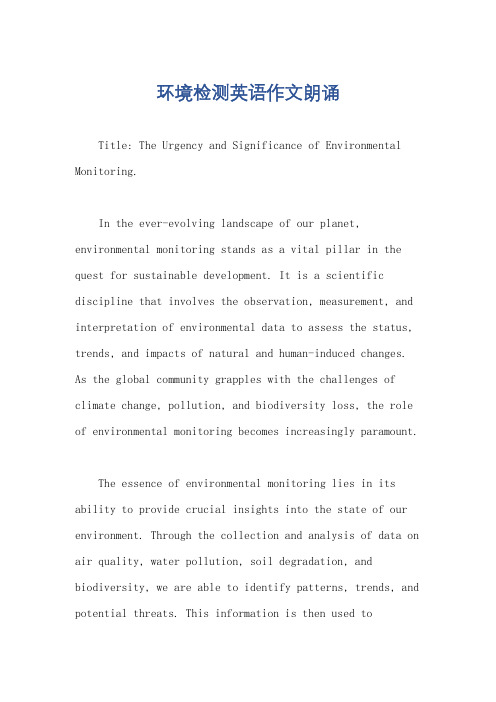
环境检测英语作文朗诵Title: The Urgency and Significance of Environmental Monitoring.In the ever-evolving landscape of our planet, environmental monitoring stands as a vital pillar in the quest for sustainable development. It is a scientific discipline that involves the observation, measurement, and interpretation of environmental data to assess the status, trends, and impacts of natural and human-induced changes. As the global community grapples with the challenges of climate change, pollution, and biodiversity loss, the role of environmental monitoring becomes increasingly paramount.The essence of environmental monitoring lies in its ability to provide crucial insights into the state of our environment. Through the collection and analysis of data on air quality, water pollution, soil degradation, and biodiversity, we are able to identify patterns, trends, and potential threats. This information is then used toformulate policies, design interventions, and track progress towards environmental goals.One of the most significant aspects of environmental monitoring is its contribution to the fight against climate change. The continuous monitoring of greenhouse gas emissions, temperature patterns, and other climate-related indicators helps us understand the severity of the crisis and take appropriate measures. For instance, data collected from environmental monitoring stations can inform policies on reducing fossil fuel usage, promoting renewable energy, and enh.。
环境监测风险分析(翻译初稿)
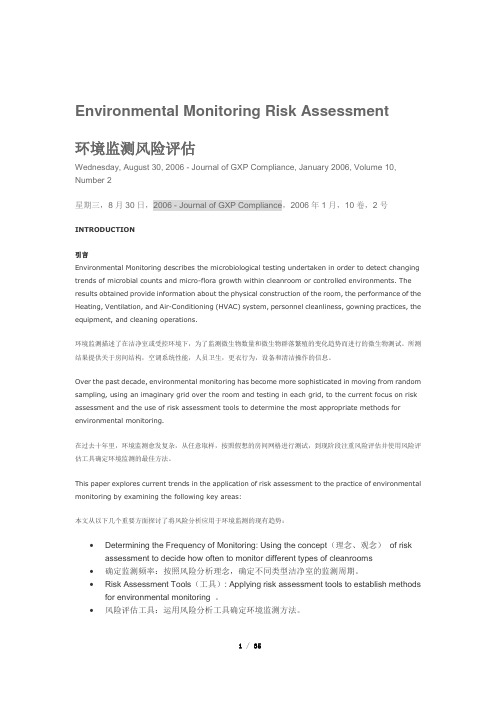
Environmental Monitoring Risk Assessment环境监测风险评估Wednesday, August 30, 2006 - Journal of GXP Compliance, January 2006, Volume 10, Number 2星期三,8月30日,2006 - Journal of GXP Compliance,2006年1月,10卷,2号INTRODUCTION引言Environmental Monitoring describes the microbiological testing undertaken in order to detect changing trends of microbial counts and micro-flora growth within cleanroom or controlled environments. The results obtained provide information about the physical construction of the room, the performance of the Heating, Ventilation, and Air-Conditioning (HVAC) system, personnel cleanliness, gowning practices, the equipment, and cleaning operations.环境监测描述了在洁净室或受控环境下,为了监测微生物数量和微生物群落繁殖的变化趋势而进行的微生物测试。
所测结果提供关于房间结构,空调系统性能,人员卫生,更衣行为,设备和清洁操作的信息。
Over the past decade, environmental monitoring has become more sophisticated in moving from random sampling, using an imaginary grid over the room and testing in each grid, to the current focus on risk assessment and the use of risk assessment tools to determine the most appropriate methods for environmental monitoring.在过去十年里,环境监测愈发复杂,从任意取样,按照假想的房间网格进行测试,到现阶段注重风险评估并使用风险评估工具确定环境监测的最佳方法。
- 1、下载文档前请自行甄别文档内容的完整性,平台不提供额外的编辑、内容补充、找答案等附加服务。
- 2、"仅部分预览"的文档,不可在线预览部分如存在完整性等问题,可反馈申请退款(可完整预览的文档不适用该条件!)。
- 3、如文档侵犯您的权益,请联系客服反馈,我们会尽快为您处理(人工客服工作时间:9:00-18:30)。
Risk of Pathogenic Contamination
1.Our facility is a dry environment. Water is not used in any part of our process including cleaning or processing.
Our products are dry. Our dry edible beans have a water activity of ≤ 0.87 (source:
.ca/agriculture/food-safety/at the food processor)
Water Activity needed for these micros to reproduce
Bacillus cereus 0.93
Clostridium botulinum 0.97
C. perfringens 0.95
Pathogenic E. coli 0.95
Salmonella spp. 0.95
Source: Cereal foods World 26:345-349, page 83, Beuchat, L.R.
2.Microbiological hazards are not inherent in the product or the environment. It is possible, however, for external
pathogens (such as E Coli, Salmonella, etc.) to become attached to beans at the farm or, in some cases, at these facilities.
Time and Temperature needed to kill these pathogens:
Temp Time Where Source
Bacillus cereus 203°F 2 minutes Internal Thermal Inactivation, Ashtown Research, Dublin (2005)
Clostridium botulinum 180°F 10 minutes Internal Colorado State Univ. Botulism Fact Sheet
C. perfringens 212°F > 1.9 minutes Internal Thermal Inactivation, Ashtown Research, Dublin (2005)
Pathogenic E. coli 194°F > 90 seconds Internal Internal Journal of food Protection, April 2008*
Salmonella spp. 165°F <10 seconds Internal Science of Cooking, Important Temperatures
*M. L. BARI, Y. INATSU, S. ISOBE, and S. KAWAMOTO (2008) Hot Water Treatments To Inactivate Escherichia coli O157:H7 and Salmonella in Mung Bean Seeds. Journal of Food Protection: April 2008, Vol. 71, No. 4, pp. 830-
834.
The University of Nebraska, Lancaster County Extension Education, states that to properly cook beans, the beans are to come to a boil (212°F) and then be simmered (defined by several publications as 185°F plus) for 1.5-2.0 hours. Such cooking will inactivate all the above-mentioned pathogens. Since all beans cleaned/sorted/packaged at this facility will be cooked after they leave these facilities, pathogens are not a concern.
Risk of Spoilage Organisms in Beans
1.Spoilage Organisms of potential concern for dry edible beans are molds. Molds require a combination of product
moisture, environmental relative humidity and environmental temperature to form.
2.Mold growth occurs on beans stored at 70o F when the relative humidity is greater than 75% (which equates to
about 16% product moisture). (M. A. UEBERSAX and C. L. BEDFORD: Navy Bean Processing: Effects of Storage and Soaking methods on Quality of Canned Beans, Michigan State University Agricultural Experiment Station East Lansing, December 1980)
3. At our facility, the average moisture of beans received in a normal year is 15%. The average moisture of beans
shipped from our facility is about 12.5%.
4.The table below shows the average temperature and relative humidity in North Dakota for months normally
associated with storing dry edible beans and what the equilibrium moisture content for edible beans would be under these conditions. Note: The equilibrium moisture content is the moisture content at which the material is neither gaining nor losing moisture.
(Table from K.J. HELLEVANG, Grain Moisture Content Effects and Management, NDSU Extension Service, March 1995)
Based on the above data, mold will not form in our dry beans under normal conditions. Our beans average 15% moisture. The average temperature, relative humidity and moisture content of beans during the normal storage period will not support the formation of molds.。
